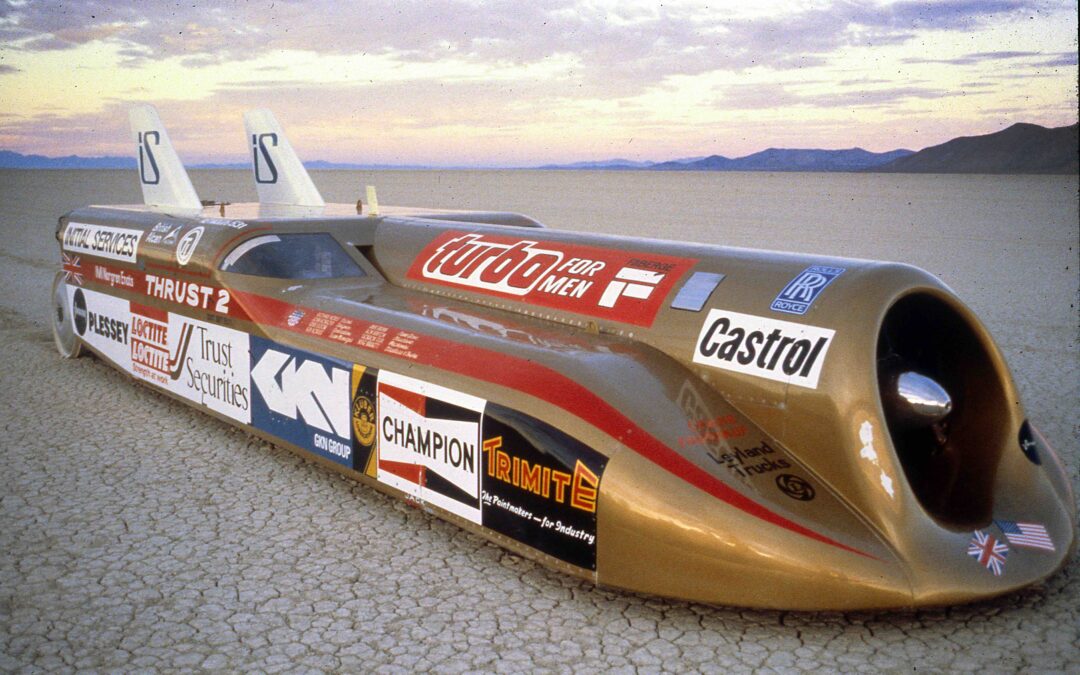Richard Noble didn’t require official approval to find out if ThrustSSC had become the first car to breach the sound barrier. All he would have needed to do was ask nearby residents if the team’s ambitious attempt to drive past Mach 1 in Nevada’s Black Rock Desert had succeeded.
“Of course, they already knew that in the small town of Gerlach, 15 miles [away]. The shockwaves knocked covers off the school classroom sprinklers, threw plates off dresser shelves and upset the postmistress – indeed the bangs could be heard over 100 miles away. It was 100 per cent convincing and it was over.”
The race for the record may been over but the quest for speed was not. Noble became the Fastest Man on Earth when Thrust2 clocked an average of 633.468 over two runs across the same Nevada desert in 1983. This record held until Noble himself broke it by masterminding ThrustSSC’s successful supersonic drive in 1997. But even that wasn’t fast enough for Noble and the adventurous Briton went onto to set-up the BloodhoundSSC project in a bid to beat the 1000mph mark.

Even’s Noble’s ferocious energy, and the creation of a purpose built venue in Hakskeenpan in South Africa’s Northern Cape province, involving shifting 16,000 tonnes of surface stone by hand over a seven-year-period, were not enough to see BloodhoundSSC make a record attempt in anger. BloodhoundSSC fell into bankruptcy and was bought by Yorkshire businessman Ian Warhurst in 2019, some 12 years after the project’s inception.
Noble is remarkably sanguine about handing over that many years work, describing it as the “best possible outcome”, and this approach reflects the book’s title, Take Risk, because success often involves failure – as the Thrust project demonstrates. The reason Noble broke the land speed record in a car called Thrust2 is because Thrust1 came to an untimely – and nearly – lethal end.
The author cheerfully admits that Thrust1, “was never a safe vehicle”, but the lure of breaking the British land speed record was too much to ignore and in March 1977 he headed to RAF Fairford and a bid for the crown. But the jet engines were too powerful and on the second run they did what they were designed for and sent Thrust1 airborne, the car performed a triple roll before smashing back down onto the runway. The fireman on the scene attempted to reassure Noble’s long-suffering wife with the good news that, “it’s only white smoke, there’s no fire”.

The firefighter’s optimism proved well-founded. While Thrust1 was a write-off Noble wasn’t.
“We scooped up the remains of Thrust1 and put it on the trailer. The sensible thing to do was for all of us to go to the pub…On the way home we found a local scrapyard that was still open and traded the remains of Thrust1 for £175. The scrappie was delighted with his purchase.”
Noble’s name may be inextricably linked with the land speed record, but his story is steeped in British aviation history; Thrust1 was powered by a Rolls-Royce Derwent 8 engine from the iconic Meteor jet. ThrustSSC was catapulted across the Nevada desert by 35,000 horsepower generated by Lightening Avon 210 Jet engine, while the project itself received large amount of cash from a complex system involving refunding used British Airways tickets.
Support from the aviation establishment for Noble’s projects was fickle, however, British Airways pulled out of Thrust2 because it was too dangerous, the company’s marketing director thought its corporate values were better represented by sponsoring orchestras. Rolls-Royce not only refused Noble use of an RB211 jet engine to power his proposed Atlantic Sprinter’s attempt to become the fastest boat to cross the Atlantic, its board issued a company-wide edict banning employees from working on the project in their free time.

Ultimately the Sprinter project didn’t make it into the water and the three-way race, including Richard Branson’s Challenger and an Italian team back by the Aga Khan, was won when the Destiero crossed the Atlantic at an average speed of 53.09 knots in 1992. The ultimate competitor Noble laments the failed chance to take on the Aga Khan for the Blue Ribband saying it would “have been the greatest boat race of all time”.
It’s no surprise that Branson’s name isn’t included – his Challenger II crossed the Atlantic at an average speed of 36 knots, creeping just ahead of the 34.5. knots achieved by the SS United States in 1952. When Branson was refused the Hales Trophy for the fastest Atlantic crossing because Challenger II wasn’t a passenger boat, “Richard responded by creating his own”.
Take Risk is a rollicking read that tells the tale not only of the land speed record but also what the author views as the risk-averse nature of British government and business. He highlights the story of Miles 52; a ground-breaking UK jet aircraft designed in 1943 and cancelled in 1946 on the grounds a British government official didn’t think supersonic flight would happen any time soon. American Chuck Yeager broke the sound barrier in in October 1947.
“Perhaps if someone had stepped forward and saved the Miles 52, the British would have achieved the first-ever supersonic flight and advanced the entire aviation industry with tens of thousands of new jobs.”

It’s impossible to know the answer to that question but Noble differentiates between fear of risk and the understanding of it arguing that complex projects often fail because of an inability to distinguish between these two concepts.
“To understand risk, you have to welcome it, live with it, encourage it and accept its consequences every day. Acceptance of risk is the big differentiator. Failure to accept and live with daily risk leads to a very sterile climate in which innovation happens elsewhere and the economy suffers from…delayed decisions, prolonged development and severely increased costs.”
If you follow those principle you might break the land speed record.

